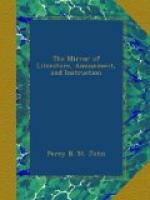Omniscience displayed in the constitution of the Atmosphere.
In the constitution of the atmosphere we have ample scope to admire the design and execution of a structure calculated, with such wondrous precision, to fulfil its purposes. Were the atmosphere to consist wholly of oxygen; and the different kinds of objects which compose, and are found upon, the globe, to remain what they are; the world would run through its stages of decay, renovation, and final destruction, in a rapid cycle. Combustion, once excited, would proceed with ungovernable violence; the globe, during its short existence, would be in a continual conflagration, until its ashes would be its only remains: animals would live with hundred-fold intensity, and terminate their mortal career in a few hours. On the other hand, were the atmosphere wholly composed of azote, life could never have existed, whether animal or vegetable, and the objects of the Creator in forming this world would not be fulfilled. But the atmosphere is a wholesome mixture of these two formidable elements, each neutralizing the other’s baneful influence. The life of animals quietly runs through its allotted space; and the current of nature flows within prescribed limits, manageably and moderately.
Tartaric Acid.
Every one knows, that when a large quantity of the juice of grapes is left to spontaneous fermentation, the result is wine. When wine has been kept some time to depurate in wooden vessels, it deposits, on the side of the vessel, a hard crust of dark coloured matter, the taste of which is sour. This matter is impure; but, when purified by various crystallizations, it becomes perfectly white and crystalline; and then it is known in commerce by the name of cream of tartar. The etymology of the singular name, tartar, is uncertain: it is derived from tartaros, as some say, because it occasions pains equal to those endured in the infernal regions; and, as others say, merely because this substance deposits itself in the inferior parts of the cask. Tartaric acid may be obtained from cream of tartar by a process analogous to that given for obtaining citric acid. It has an exceedingly acid taste: it dissolves readily in water, and is soluble in alcohol. Its crystals are of a very irregular shape. In 100 parts,




